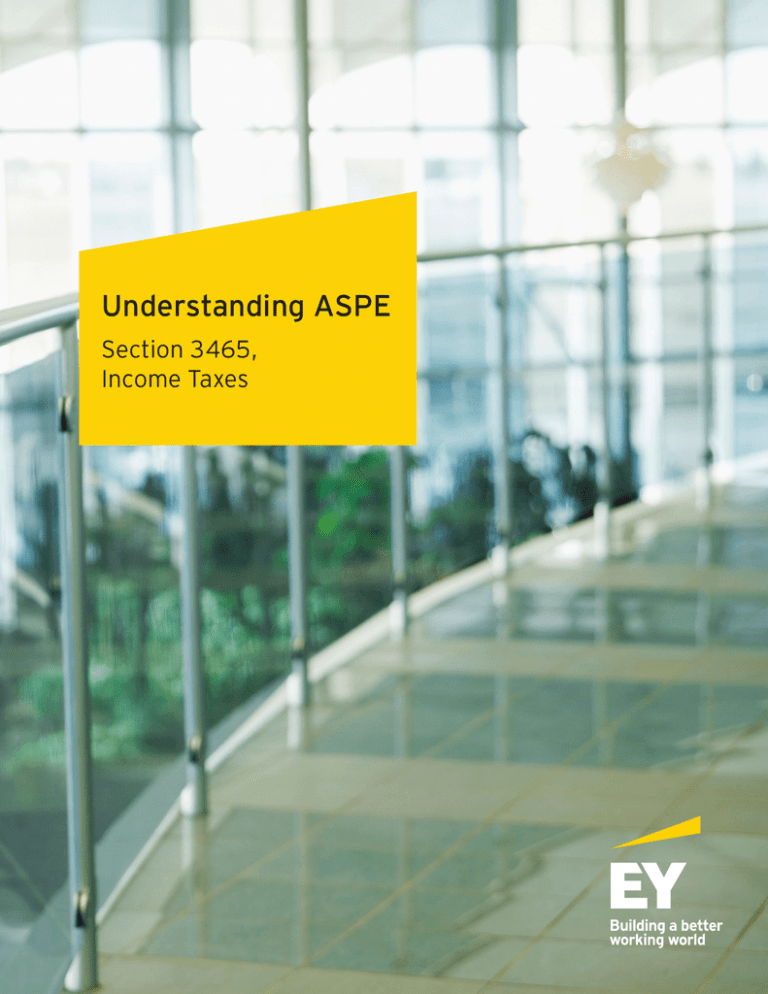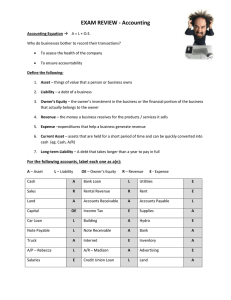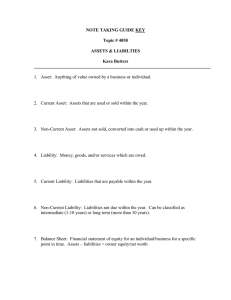
Understanding ASPE
Section 3465,
Income Taxes
Six questions for private business owners:
Income Taxes
A better working world begins with better questions. Asking better questions leads to better
answers. To help preparers of financial statements with Canadian accounting standards for private
enterprises (“ASPE”) Section 3465, Income Taxes, we’ve summarized the key aspects of the
Section and offer relevant practical considerations for private mid-market companies through
answering six commonly asked questions.
Section 3465 states that when accounting for
income taxes, an entity has the choice to use:
(a) the taxes payable method; or
(b) the future income taxes method.
The taxes payable method, as defined in
paragraph 3465.02 (l), is a method of
accounting under which an enterprise reports
as an expense (income) of the period only
the cost (benefit) of current income taxes for
that period, determined in accordance with the
rules established by taxation authorities.
The future income taxes method, as defined
in paragraph 3465.02 (f), is a method of
accounting under which an enterprise reports
as an expense (income) of the period the cost
(benefit) of current income taxes and the cost
(benefit) of future income taxes, determined
in accordance with the rules established by
taxation authorities.
2 | Understanding ASPE Section 3465, Income Taxes
2
Question
Question
1
What accounting policy choices are available
with respect to accounting for income taxes?
Which method should an entity choose?
The taxes payable method is easier to apply
because it does not require the measurement
of future tax assets and liabilities arising
from temporary differences. However, future
income tax assets, if any, will be left off the
balance sheet. On the other hand, the taxes
payable method requires a disclosure of a
reconciliation of the income tax rate or expenses
related to income or loss for the period before
discontinued operations to the statutory income
tax rate or the dollar amount that would result
from its application, including the nature and
amount of each significant reconciling item. The
choice depends upon the financial reporting
needs of the entity. An entity is allowed to
change income tax policies without meeting the
criterion in paragraph 1506.06(b), Accounting
Changes. The taxes payable method is not
permitted under other financial reporting
frameworks, such as International Financial
Reporting Standards and Accounting Principles
Generally Accepted in the United States
of America.
Current income taxes, to the extent unpaid
or recoverable, shall be recognized as a
liability or asset. The benefit relating to a
tax loss arising in the current period that
will be carried back to recover income taxes
of a previous period shall be recognized
as a current asset. The liability for current
income taxes included in the balance sheet
is the cost (benefit) of current income taxes
for current and prior periods less amounts
already paid in respect of these income taxes.
When the amount already paid in respect of
the cost (benefit) of current income taxes
for a period exceeds the liability for that
period, any excess amount is shown as an
asset. When a tax loss is used to recover
income taxes previously paid, the benefit is
recognized in the period in which the tax loss
occurs since the benefit will be realized.
The measurement provisions are set forth in
paragraphs 3465.51-3465.58. Income tax
liabilities/assets, whether current or future,
shall be measured using the income tax rates
and laws that, at the balance sheet date, are
expected to apply when the liability is settled
or the asset is realized, which are normally
enacted at the balance sheet date. When a
change in income tax rates or income tax laws
is substantively enacted before the balance
sheet date, income tax liabilities and income
tax assets are measured using the announced
tax rates or tax laws.
4
Question
Question
3
If an entity chooses the taxes payable
method, when are income taxes recognized
and what tax rate is used to measure
income tax assets and liabilities?
What are the basic principles of the future
income taxes method?
Per paragraph 3465.10, the fundamental
principle upon which the future income
taxes method is based is that an enterprise
recognizes a future income tax liability
whenever recovery or settlement of the
carrying amount of an asset or liability would
result in future income tax outflows. Similarly,
an enterprise recognizes a future income tax
asset whenever recovery or settlement of the
carrying amount of an asset or liability would
generate future income tax reductions.
The determination of whether recovery or
settlement of an asset or liability will result
in future income tax outflows or benefits is
determined by reference to the difference
between the carrying values and tax basis of
assets and liabilities. This difference arises
when the rules established by the taxation
authorities to determine the taxable income
that will arise from the recovery or settlement
of an asset or liability are different from the
accounting policies followed by an enterprise
when determining the income or expense
recorded in their financial statements. The
tax basis of an asset or liability is the amount,
determined with reference to the rules
established by the taxation authorities, that
could be deducted in the determination of
taxable income if the asset were recovered
or the liability were settled for its carrying
amount. At any point in time, there may
be a difference between the tax basis of an
asset or liability and its carrying amount.
Such differences are temporary differences.
Temporary differences may be either taxable
or deductible. Taxable temporary differences
give rise to future income tax liabilities.
Deductible temporary differences give rise to
future income tax assets.
Understanding ASPE Section 3465, Income Taxes | 3
Question
5
What are the disclosure requirements of the two methods
of accounting for income taxes?
Taxes payable
Future income taxes
(a) a
reconciliation of the income
tax rate or expense related to
income/loss for the period before
discontinued operations to the
statutory income tax rate or the
dollar amount that would result
from its application, including
the nature and amount of each
significant reconciling item;
(a) c urrent and future income tax
expense (benefit) included in the
determination of income or loss
before discontinued operations;
(b) t he amount and timing of capital
gain reserves to be included in
taxable income within five years;
(c) t he total amount of unused tax
losses and income tax reductions,
and the amount of deductible
temporary differences, for which
no future income tax asset has
been recognized.
(c) t he amount of unused income tax
losses carried forward and unused
income tax credits; and
(d) t he portion of income tax expense
(benefit) related to transactions
charged (or credited) to equity
4 | Understanding ASPE Section 3465, Income Taxes
(b) t he portion of the cost (benefit)
of current and future income taxes
related to capital transactions or
other items that are charged or
credited to equity
Question
6
What are refundable taxes and how are they accounted for?
As defined in paragraph 3465.02 (b), refundable taxes are taxes
that are based on certain types of income and that are refundable
when certain amounts are paid to shareholders. These taxes are
applicable to certain investment income earned by Canadian
corporations and are refundable when certain distributions are paid
to shareholders.
Per paragraphs 3465.67-3465.70, when a payment related to a
component of an instrument classified as a liability will give rise to
a refund of income taxes previously paid, the refundable amount
shall be recognized as a future income tax asset. Refundable taxes
that are in nature of advance distributions related to a component
of an equity instrument shall be charged to retained earnings when
it is more likely than not that such taxes will be recovered in the
foreseeable future. The recovery of such refundable taxes shall be
credited to retained earnings. When it is not more likely than not that
the taxes will be recovered in the foreseeable future, the taxes shall
be charged to income.
To learn more about these items or
for application guidance, please contact
our Private Mid-Market practice at
privatecompanyinfo@ca.ey.com.
Understanding ASPE Section 3465, Income Taxes | 5
A better
working world
begins with
better questions.
6 | Understanding ASPE Section 3465, Income Taxes
Understanding ASPE Section 3465, Income Taxes | 7
EY | Assurance | Tax | Transactions | Advisory
About EY
EY is a global leader in assurance, tax, transaction and advisory services.
The insights and quality services we deliver help build trust and confidence
in the capital markets and in economies the world over. We develop
outstanding leaders who team to deliver on our promises to all of our
stakeholders. In so doing, we play a critical role in building a better working
world for our people, for our clients and for our communities.
EY refers to the global organization, and may refer to one or more, of the
member firms of Ernst & Young Global Limited, each of which is a separate
legal entity. Ernst & Young Global Limited, a UK company limited by
guarantee, does not provide services to clients. For more information about
our organization, please visit ey.com.
For more information about our organization, please visit ey.com/ca.
© 2015 Ernst & Young LLP. All Rights Reserved.
A member firm of Ernst & Young Global Limited.
1567865
ED None
This publication contains information in summary form, current as of the date of publication, and
is intended for general guidance only. It should not be regarded as comprehensive or a substitute
for professional advice. Before taking any particular course of action, contact Ernst & Young or
another professional advisor to discuss these matters in the context of your particular circumstances.
We accept no responsibility for any loss or damage occasioned by your reliance on information
contained in this publication.
ey.com/ca






